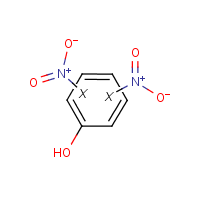Dinitrophenol
Agent Name
Dinitrophenol
CAS Number
25550-58-7
Formula
C6-H4-N2-O5
Major Category
Nitrogen Compounds

Synonyms
Dinitroaminophenol; Phenol, dinitro-; p-Dinitrophenol; Dinitrophenol solutions; [ChemIDplus] UN0076; UN1320; UN1599
Category
Nitrophenols
Description
Yellow solid; [Hawley]
Sources/Uses
Used in the manufacturing of dyes, wood preservatives, and insecticides; used as "a reagent for the detection of potassium and ammonium ions"; [HSDB] Nitrophenolic and nitrocresolic herbicides are used in some parts of the world as acaricides, nematicides, ovicides, and fungicides. "Only dinocap continues to have active registrations in the United States." [EPA Pesticides, p. 104] Used to make diaminophenol hydrochloride (photographic developer) and explosives; [Hawley]
Comments
May cause skin burns; [HSDB] The pathophysiology, like that of pentachlorophenol, involves the uncoupling of oxidative phosphorylation. Yellow stains appear on the skin after dermal contact with the nitroaromatic herbicides. Fatal poisoning can occur after dermal absorption. Cataracts have been reported in animal experiments and after occupational exposure. In severe poisoning, these herbicides can cause injury to the liver and kidneys. [EPA Pesticides, p. 104-5] Secondary acute renal failure after dinitrophenol and dinitro-o-cresol poisoning has been reported. [LaDou, p. 418] There is a case report of dinitrophenol causing cholestatic jaundice. [Zimmerman, p. 351] Listed in table of "Methemoglobinemia-inducing agents: industrial, environmental, and pharmaceutical"; [Sullivan, p. 729] Solid form can cause first degree burns after short skin exposure; [CHRIS] Extremely hazardous explosion hazard when dry; [Hawley]
Restricted
Emergency suspension & cancellation of registration as herbicide in 1986.
Biomedical References
Exposure Assessment
Vapor Pressure
1.2E-05 mm Hg
Explanatory Notes
The Guide in the Emergency Response Guidebook is for UN1599: "Dinitrophemol, solution." UN1320 (Guide 113) is for "Dinitrophenol, wetted with not less than 15% water."
Reference Link #2
Adverse Effects
Methemoglobinemia
MetHgb is secondary toxic effect
Hepatotoxin
Hepatoxic (a) from occupational exposure (secondary effect) or (b) in animal studies or in humans after ingestion
Nephrotoxin
Yes
Dermatotoxin
Skin burns
Other Poison
Uncoupler
Diseases, Processes, and Activities Linked to This Agent
Diseases
Occupational diseases associated with exposure to this agent:
Processes
Industrial Processes with risk of exposure: